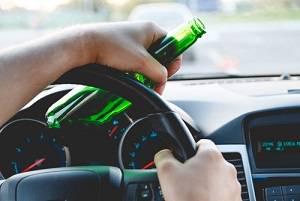Recent Blog Posts
Snowmobilers Who Drink and Drive: What's the Law?
 By James Lewis
By James Lewis
Winter in Wisconsin is in full-swing now, and more than 25,000 miles of snowmobile trails are open. The 2016-17 snowmobile season will see more than 200,000 riders throughout the state. Before taking to the trails, it is important that you know about how Wisconsin OWI laws affect snowmobile operators.
First, if you are driving your snowmobile on a public trail, road or highway, then Wisconsin OWI laws, the legal limit (.08 BAC) and penalties will likely apply to you if you drink alcohol and drive your snowmobile. If you are on private property, then the rules on having to submit to a chemical test may differ, unless another criminal offense or accident has occurred. Going off-trail, onto lakes, etc., can vary the penalties that apply. Fines for a snowmobile OWI can range between $400 and $2000, depending on how many similar infractions you have on your record and the nature of the incident. In addition to fines, drivers found to be operating under the influence of alcohol may also have their privilege to operate a snowmobile revoked by a court upon conviction. However, unlike automobile OWI law, which counts the lifetime number of prior OWI violations, the snowmobile OWI laws only count violations within the previous five years.
Helping Your Child Recover after a Concussion
 Each year, around 2.5 million people visit the emergency room for a traumatic brain injury (TBI). Some of those visitors are children who sustained their injury during an automobile crash. In fact, according to the Centers for Disease Control and Prevention, motor vehicle crashes are the leading cause of TBI among children and young adults between five and 24 years of age. If your child has suffered a concussion because of a traffic accident, learn how you can help them recover, and what your legal rights are regarding compensation.
Each year, around 2.5 million people visit the emergency room for a traumatic brain injury (TBI). Some of those visitors are children who sustained their injury during an automobile crash. In fact, according to the Centers for Disease Control and Prevention, motor vehicle crashes are the leading cause of TBI among children and young adults between five and 24 years of age. If your child has suffered a concussion because of a traffic accident, learn how you can help them recover, and what your legal rights are regarding compensation.
Study Finds Parents Are Often Too Restrictive after Brain Injuries
Children who suffer a concussion need rest, but researchers from the UCLA Health say parents are actually giving their children too much downtime after injury. Exercise is important to their recovery, as long as it does not put them at risk for further injury (no sports and no “rough” play). So is socialization with their peers. Parents should also avoid waking their child up in the night to check on them since a lack of sleep, which is often the result of this outdated advice, might make their headache and mood worse. In short, protect your child, but still give them a chance to be a child.
How to Conduct Yourself If You Are Stopped by a Police Officer
 The majority of police officers are good and rational human beings. Nonetheless, police brutality, aggression, and confrontational behavior does exist. Knowing how to handle such situations should you ever experience one, is critical. In fact, in some situations, it could very well save your life. At the very least, an understanding of your Constitutional rights and thoughtful action can help reduce the risk of a wrongful arrest, wrongfully filed charges and wrongful conviction. The following explains further.
The majority of police officers are good and rational human beings. Nonetheless, police brutality, aggression, and confrontational behavior does exist. Knowing how to handle such situations should you ever experience one, is critical. In fact, in some situations, it could very well save your life. At the very least, an understanding of your Constitutional rights and thoughtful action can help reduce the risk of a wrongful arrest, wrongfully filed charges and wrongful conviction. The following explains further.
Understanding Your Risk
Anyone can experience police brutality or aggression. However, there are some groups who are at an increased risk. For example, African American males are three times more likely to be killed by an officer of the law than any other race. Further compounding this issue is that African-American men are far more likely to be stopped by a police officer than other racial groups. Whoever you are, it is critical that you understand how you can attempt to de-escalate a situation and protect your rights.
Social Media Use and Your Personal Injury Lawsuit – What You Need to Know
 Social media can have its benefits – it can help families and friends stay in touch when they live in different parts of the country, and it has even sparked new relationships. Unfortunately, social media also has its drawbacks, particularly for those who are pursuing a personal injury lawsuit. Before you share, tweet, or otherwise post something about your personal life to social media, learn what kinds of posts could impact the amount or success of your case.
Social media can have its benefits – it can help families and friends stay in touch when they live in different parts of the country, and it has even sparked new relationships. Unfortunately, social media also has its drawbacks, particularly for those who are pursuing a personal injury lawsuit. Before you share, tweet, or otherwise post something about your personal life to social media, learn what kinds of posts could impact the amount or success of your case.
Understanding How Personal Injury Lawsuits Work
When a victim brings forth a lawsuit against a negligent party, they are attempting to recover damages caused by the accident they experienced. Medical expenses and lost income are generally a part of this settlement, but they are paid according to the victim’s actual costs. More obscure recovery types – pain and suffering, loss of vitality, and other noneconomic damages – are not as easily calculated. The victim must explain how the injury has affected their life. To reduce their payout amount, the insurance company will often attempt to collect evidence that suggests the victim’s life may not have been as drastically altered as they claim. This is where social media can get victims into serious trouble.
Study Examines the Growing Prevalence of Pedestrian Accidents
 Because they have such a high prevalence of fatality, pedestrian accidents have always been a major area of concern. In fact, many states and cities have implemented awareness initiatives, new and updated traffic control devices, and stricter laws to protect their pedestrian citizens. Yet the growing problem shows that the issue is getting worse instead of better. A recent study attempted to understand why, despite all efforts, the prevalence of pedestrian accidents seems to be growing. They also looked at possible pedestrian accident risk factors and the losses that victims may experience.
Because they have such a high prevalence of fatality, pedestrian accidents have always been a major area of concern. In fact, many states and cities have implemented awareness initiatives, new and updated traffic control devices, and stricter laws to protect their pedestrian citizens. Yet the growing problem shows that the issue is getting worse instead of better. A recent study attempted to understand why, despite all efforts, the prevalence of pedestrian accidents seems to be growing. They also looked at possible pedestrian accident risk factors and the losses that victims may experience.
How Big Is the Problem?
In the year 2004 alone, the National Highway Traffic Safety Administration (NHTSA) reported more than 70,000 pedestrian injuries and more than 4,600 pedestrian deaths. On average, that means that one pedestrian is killed every 113 minutes, and every eight minutes, one is injured. In Wisconsin, specifically, pedestrian fatalities account for approximately 9 percent of all annual traffic fatalities (about 60 per year) and around 350 are seriously injured. That averages out to about one pedestrian death or injury in Wisconsin every five hours.
Hate Crimes Surging throughout the USA and the Penalties in Wisconsin

Over the last year, hate crimes have increased dramatically across the country. Hate crimes against African American and Muslim Americans have risen by over 50% and have reached their highest numbers since 2001. Hate crimes against Hispanics have increased almost 40% during the same time period.
The Southern Poverty Law Center (SPLC) reports that in the month since the November 2016 election, it has documented 437 reports of hate-fueled intimidation and harassment through news reports, social media and direct submissions via the SPLC’s #ReportHate form. Most involved anti-immigrant, anti-black or anti-LGBT bigotry. The most frequent location was K-12 schools, followed by businesses and at universities.
What are the consequences of such actions? The following provides a brief overview.
What Is a Hate Crime?
Dec. 30th Deadline for Federal Mortgage Relief for Homeowners

The time to act for Wisconsin homeowners struggling to make their mortgage payments is now! This is because the deadline to apply for the federal government’s long-running Making Home Affordable Program (MHA) Home Affordable Modification Program (HAMP) expires at the end of this month, on December 30, 2016.
An attorney at GRGB says that homeowners faced with this concern need to act before December 30, 2016, if they want to take advantage of this federal assistance program, and should consult with legal counsel about their options or if they have questions on how to proceed. They are experienced in mortgage loan, lending, foreclosures and consumer law, and points out a recent article that provides a very good overview and how-to on the subject.
The article, written by Attorney Rebecca Unruh, who is with the Federal Trade Commission’s Division of Financial Practices, sets out the necessary steps one needs to take in order to apply for relief under HAMP. The link to the FTC article is found at - - https://www.consumer.ftc.gov/blog/struggling-make-your-mortgage-payments
When an OWI Can Result in Serious, Lifelong Consequences
 Generally, jail terms are reserved for Wisconsin’s repeat OWI offenders. However, there are circumstances under which even a first-time offender can face serious penalties. It is important to understand these circumstances. Moreover, it is essential that you understand how to protect yourself, should you come up against any one of these serious situations.
Generally, jail terms are reserved for Wisconsin’s repeat OWI offenders. However, there are circumstances under which even a first-time offender can face serious penalties. It is important to understand these circumstances. Moreover, it is essential that you understand how to protect yourself, should you come up against any one of these serious situations.
Multiple OWI Convictions
If you receive a second offense OWI within a ten-year period, you can face up to six months in jail. Each repeat offense can increase your penalties and, by the time you reach your fourth offense, you could face consequences for a Class H felony, including up to six years of imprisonment, suspension of your license for up to three years, mandatory Interlock Ignition Device (IID) for up to three years and fines of up to $20,000. Additional convictions can increase your penalties even further.
Construction Zone Accidents Can Have Multiple Negligent Parties
 In the past five years, almost 4,500 people have been killed in construction zones, and more than 200,000 have been injured. Sometimes, construction zone accidents are the fault of one or more drivers. Other times, the construction company or an individual worker acted with negligence. Then there are those incidents in which more than one party is at fault. Such was the case in a fatal crash along Interstate 75 in Tennessee, where as many as four different parties are being accused of negligence.
In the past five years, almost 4,500 people have been killed in construction zones, and more than 200,000 have been injured. Sometimes, construction zone accidents are the fault of one or more drivers. Other times, the construction company or an individual worker acted with negligence. Then there are those incidents in which more than one party is at fault. Such was the case in a fatal crash along Interstate 75 in Tennessee, where as many as four different parties are being accused of negligence.
Multiple Parties Accused of Negligence in Fatal Crash
In a crash that killed six people, four different parties could face consequences for negligence. The first party is the semi driver who was allegedly intoxicated when he slammed into the vehicles in front of him. Consequently, the trucking company is also being named as a negligent party because they reportedly knew that the driver had been over federal driving limits. The final two parties being named are the construction companies. Court documents allege that they had been working at a dangerous and unauthorized time and location and that they had failed to implement an effective traffic control plan.
Arrested and Charged with a Crime – What Happens Now?
 When defendants enter the criminal justice system, they are often surprised to find that little about the process lines up with what they have seen on television. Already worried about their future, and now confused, they become even more frightened because they simply do not know what to expect. To make matters worse, they get obscure answers when they inquire about their rights. If you or someone you love is facing criminal charges, the following information can help you understand what may happen next, and what your rights are during each step in the criminal process.
When defendants enter the criminal justice system, they are often surprised to find that little about the process lines up with what they have seen on television. Already worried about their future, and now confused, they become even more frightened because they simply do not know what to expect. To make matters worse, they get obscure answers when they inquire about their rights. If you or someone you love is facing criminal charges, the following information can help you understand what may happen next, and what your rights are during each step in the criminal process.
Initial Appearance
When you are charged with a crime, you will make your first appearance in court. Called your “initial appearance,” this is when the judge will explain your charges and the maximum penalty for a conviction. If you are currently in police custody, the judge may also set bail during this hearing. From there, the structure of your initial appearance depends upon the type of crime you are being charged with.







